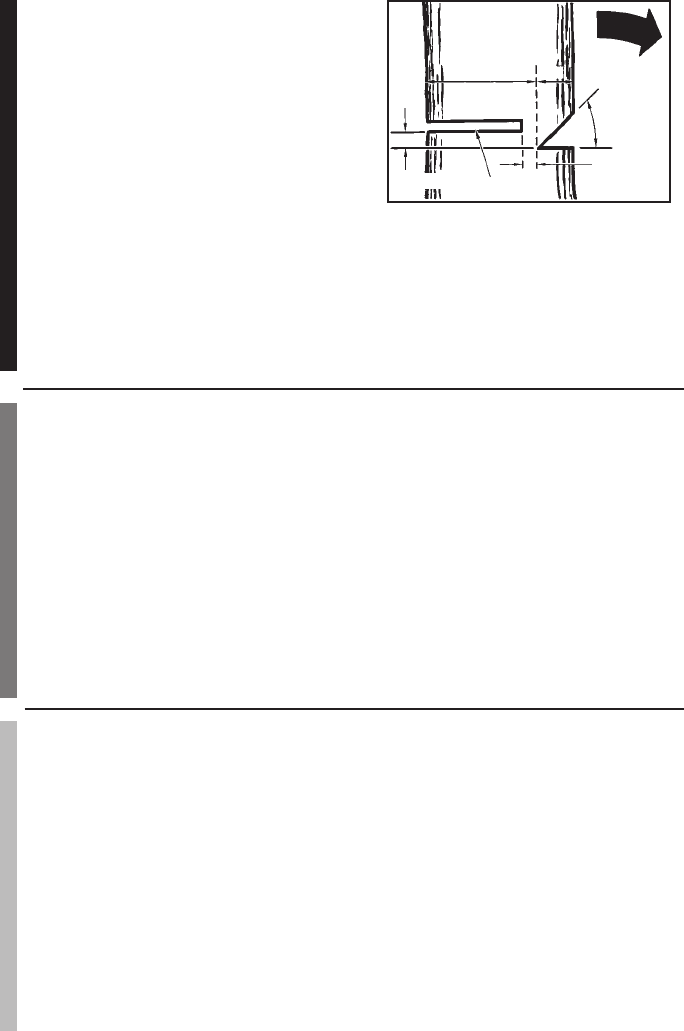
WARNING
Do not cut down a tree during high or changing winds or
if there is a danger to property. Consult a tree profes-
sional.
Do not cut down a tree if there is a danger of striking util-
ity wires; notify the utility company before making any
cuts.
GENERAL GUIDELINES FOR FELLING
TREES:
Normally felling consists of 2 main cutting operations,
notching (C) and making the felling cut (D).
Start making the upper notch cut (C) on the side of the
tree facing the felling direction (E). Be sure you don’t
make the lower cut too deep into the trunk.
The notch (C) should be deep enough to create a hinge (F) of sufficient width and strength. The notch
should be wide enough to direct the fall of the tree for as long as possible.
WARNING
Never walk in front of a tree that has been notched.
Make the felling cut (D) from the other side of the tree and 1.5” - 2.0” (3-5cm) above the edge of the notch
(C) (Figure 5-1B).
31
AVERTISSEMENT
Eviter la coupe par mauvais temps, fort vent, vent changeant ou si cela peut endommager une propriété.
Consulter un professionnel du métier.
Ne pas couper d’arbre s’il y a une possibilité de heurter des fils électriques ou autres. Prévenir les services
publics appropriés avant toute coupe.
REGLES GENERALES A OBSERVER POUR L’ABATTAGE :
En principe, l’abattage se divise en 2 opérations: l’entaille (C) et le trait d’abattage (D).
Toujours commencer par le trait diagonal (du haut) de l’entaille d’abattage (C), du côté choisi pour la chute
de l’arbre (E). Eviter de scier trop profondément l’entaille horizontale (du bas).
L’entaille d’abattage (C) doit être suffisamment ouverte pour créer une charnière (F) assez forte de largeur
suffisante et pour guider la chute de l’arbre aussí longtemps que possible.
AVERTISSEMENT
Ne jamais marcher devant un arbre entaillé.
Scier le trait d’abattage (D) de l’autre côté du tronc, 3 à 5 cm (1,5 à 2,0”) au-dessus de l’entaille d’abattage
(C) (Figure 5-1B).
ADVERTENCIA
No corte un árbol durante vientos rápidos o cambiantes o si hay peligro para una propiedad. Consulte a un
profesional de árboles.
No corte un árbol si hay peligro de que alambres de servicio sean golpeados; notifique a la compañia de
servicio antes de hacer cualquier corte.
REGLAS GENERALES PARA EL TALADO DE ARBOLES:
Normalmente el talado consiste en 2 operaciones de corte principales, haciendo la ranura (C) y realizando
el corte de talado (D).
Empiece haciendo el corte de ranura (C) superior en la parte del árbol apuntando a la dirección de caída
(E). Asegúrese de no hacer el corte inferior muy profundo dentro del tronco.
La ranura (C) deberá ser lo bastante profunda para crear una articulación (F) de suficiente anchura y
fuerza. La ranura deberá ser lo suficiente ancha para dirigir la caída del árbol por el mayor tiempo posible.
ADVERTENCIA
Nunca camine en frente de un árbor que haya sido ranurado.
Realice el corte de talado (D) desde la otra parte del árbol y 3-5cm (1.5 - 2.0”) arriba del borde de la ranu-
ra (C) (Figura 5-1B).
E
N
G
L
I
S
H
F
R
A
N
C
A
I
S
E
S
P
A
Ñ
O
L
5-1B
E
C
F
D
3
⁄4
1
⁄4
3-5cm


















